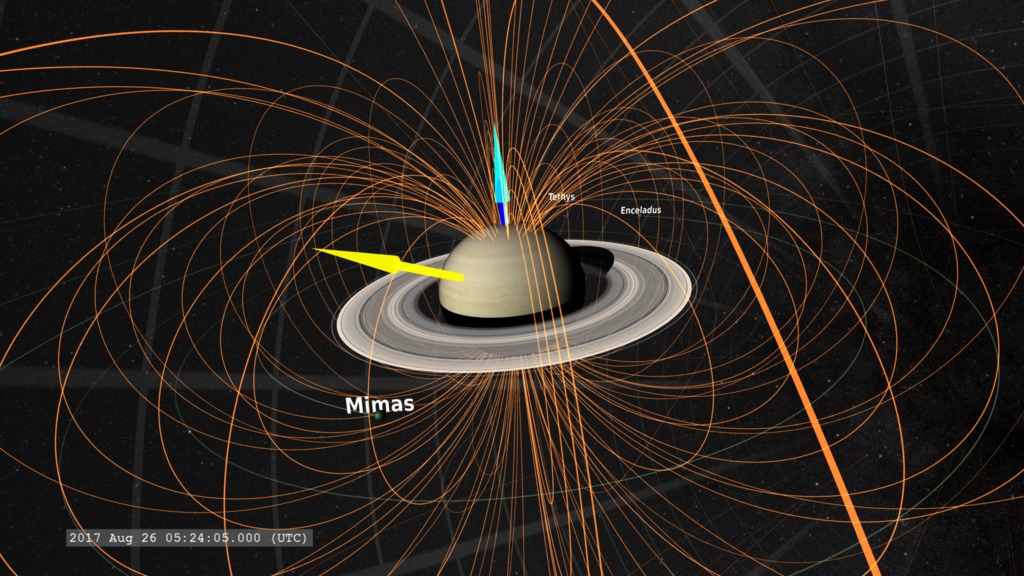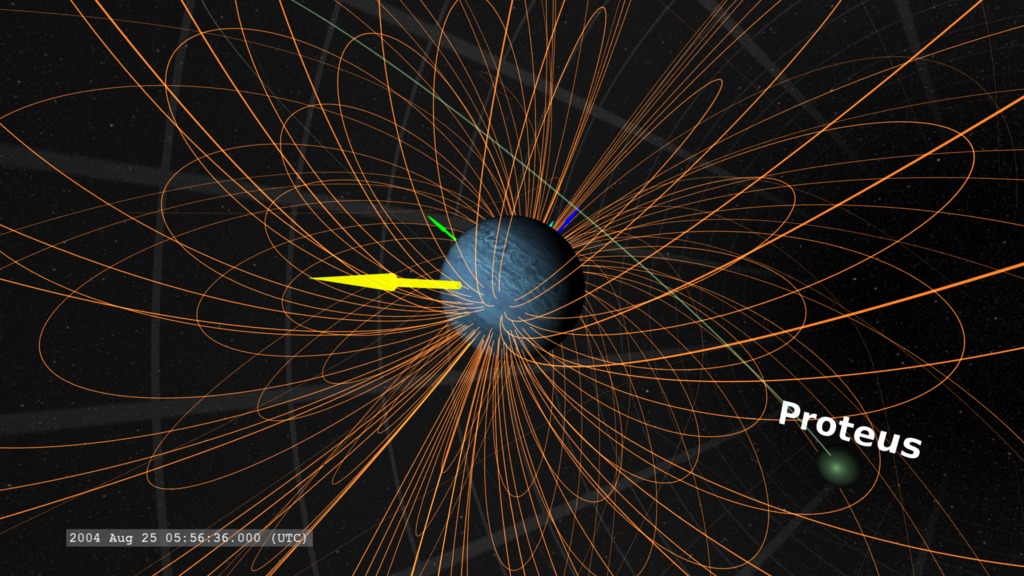Uranus' Magnetosphere
A basic view of the Uranian magnetosphere when the rotation axis is perpendicular to the Uranus-Sun line and days and nights are of equal duration.
Earth's magnetic field creates a 'bubble' around Earth that helps protect our planet from some of the more harmful effects of energetic particles streaming out from the sun in the solar wind. Some of the earliest hints of this interaction go back to the 1850s with the work of Richard Carrington, and in the early 1900s with the work of Kristian Birkeland and Carl Stormer. That this field might form a type of 'bubble' around Earth was hypothesized by Sidney Chapman and Vincent Ferraro in the 1930s. The term 'magnetosphere' was applied to magnetic bubble by Thomas Gold in 1959. But it wasn't until the Space Age, when we sent the first probes to other planets, that we found clear evidence of their magnetic fields (though there were hints of a magnetic field for Jupiter in the 1950s, due to observations from radio telescopes).
The Voyager program, two spacecraft launched in 1977, and successors to the Pioneer 10 and 11 missions, completed flybys of the giant outer planets. They became the implementation of the 'Grand Tour' of the outer planets originally proposed in the late 1960s. The Voyagers provided some of the first detailed measurments of the strength, extent and diversity of the magnetospheres of the outer planets.
In these visualizations, we present simplified models of these planetary magnetospheres, designed to illustrate their scale, and basic features of their structure and impacts of the magnetic axes offset from the planetary rotation axes.
The rotation axis of Uranus is tilted over ninety degrees relative to the revolution axis of the solar system, placing it roughly in the plane of the solar system. In addition, the magnetic axis has a large tilt relative to the rotation axis. These effects combine to not only give Uranus a more a more variable magnetosphere, but suggest the planet's magnetic field may be generated by a different mechanism than that of Earth, Jupiter and Saturn.
For these visualizations, the magnetic field structure is represented by gold/copper lines. The semi-transparent grey mesh in the distance represents the boundary of the magnetosphere. Major satellites of the planetary system are also included. When appropriate for the time window of the visualization, the Voyager flyby trajectories are indicated.
The models are constructed by combining the fields of a simple magnetic dipole, a current sheet (whose intensity is tuned match the scale of the magnetotail), and occasionally a ring current. This is a variation of the simple Luhmann-Friesen magnetosphere model. They are meant to be representative of the basic characteristics of the planetary magnetic fields. Some features NOT included are longitudes of magnetic poles to a standard planetary coordinate system and offsets of the dipole center from the planetary center.
References
- T. Gold, Motions in the Magnetosphere of the Earth
- Luhmann & Friesen, A simple model of the magnetosphere
- Magnetic reconnection at Uranus' magnetopause
- LASP: Polarity of planetary magnetic fields
- Wikipedia: The Solar Storm of 1859
- Wikipedia: Kristian Birkeland
- Wikipedia: Carl Størmer
Special thanks to Arik Posner (NASA/HQ) and Gina DiBraccio (UMBC/GSFC) for helpful pointers on orientation of planetary rotation and magnetic axes.
A basic view of the Uranian magnetosphere when the northern side of the rotation axis is directed sunward (northern summer).
A basic view of the Uranian magnetosphere during the Voyager 2 flyby.
A basic view of the Uranian magnetosphere when the rotation axis is perpendicular to the Uranus-Sun line and days and nights are of equal duration. Camera view is a distant orbit.
A basic view of the Uranian magnetosphere when the northern side of the rotation axis is directed sunward (northern summer). Camera view is a distant orbit.
Credits
Please give credit for this item to:
NASA's Scientific Visualization Studio
-
Animator
- Tom Bridgman (Global Science and Technology, Inc.)
-
Scientist
- Arik Posner (NASA/HQ)
-
Writer
- Mara Johnson-Groh (Wyle Information Systems)
-
Project support
- Laurence Schuler (ADNET Systems, Inc.)
- Ian Jones (ADNET Systems, Inc.)
Release date
This page was originally published on Friday, July 27, 2018.
This page was last updated on Monday, January 6, 2025 at 12:13 AM EST.
Series
This page can be found in the following series:Datasets used
-
Magnetic Field Lines (Luhmann-Friesen) [Luhmann-Friesen Magnetosphere Model (1979)]
ID: 615Journal of Geophysical Research, vol. 84, Aug. 1, 1979, p. 4405-4408
This dataset can be found at: http://adsabs.harvard.edu/abs/1979JGR....84.4405L
See all pages that use this dataset -
DE 430
ID: 972
Note: While we identify the data sets used on this page, we do not store any further details, nor the data sets themselves on our site.








